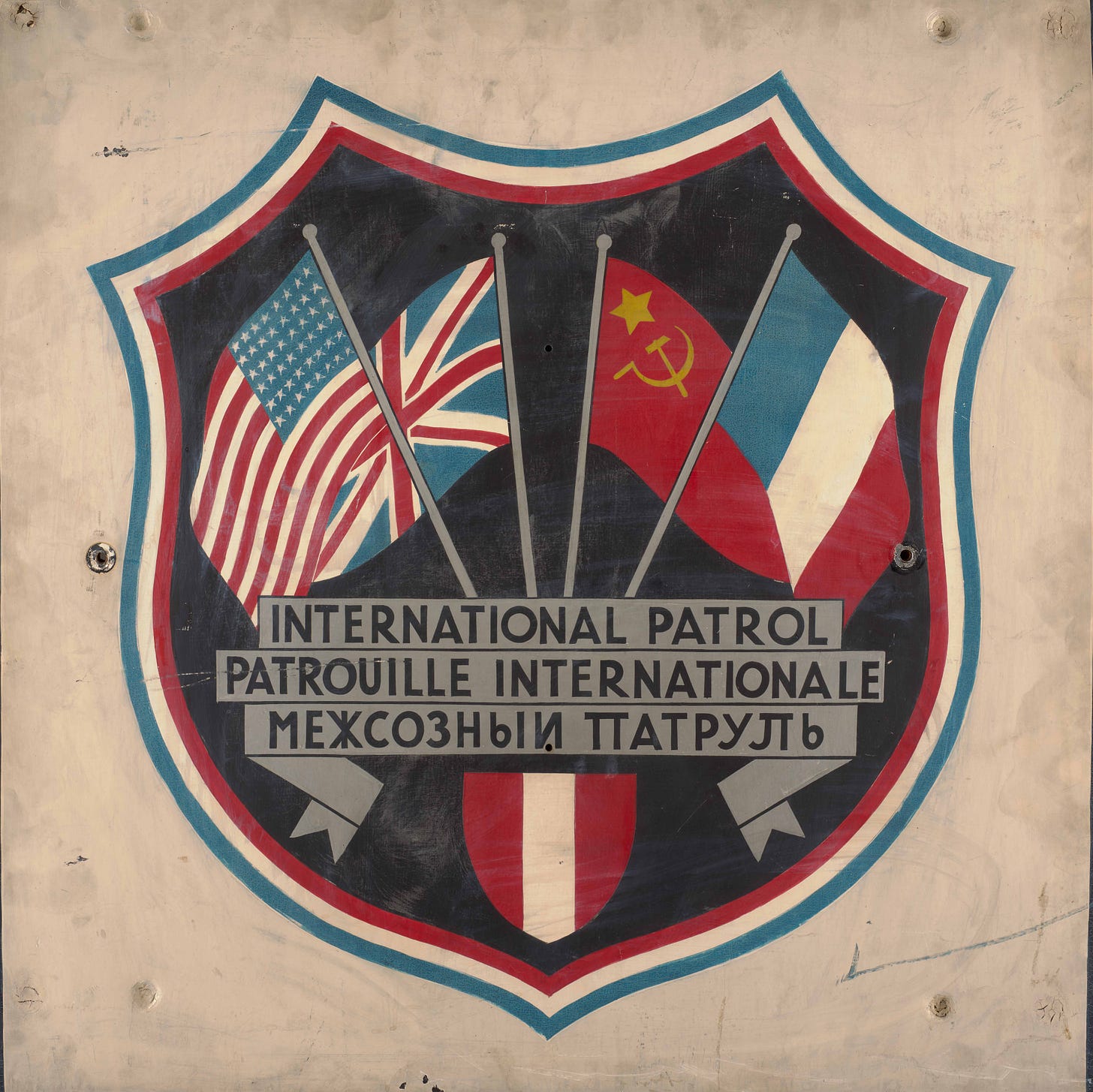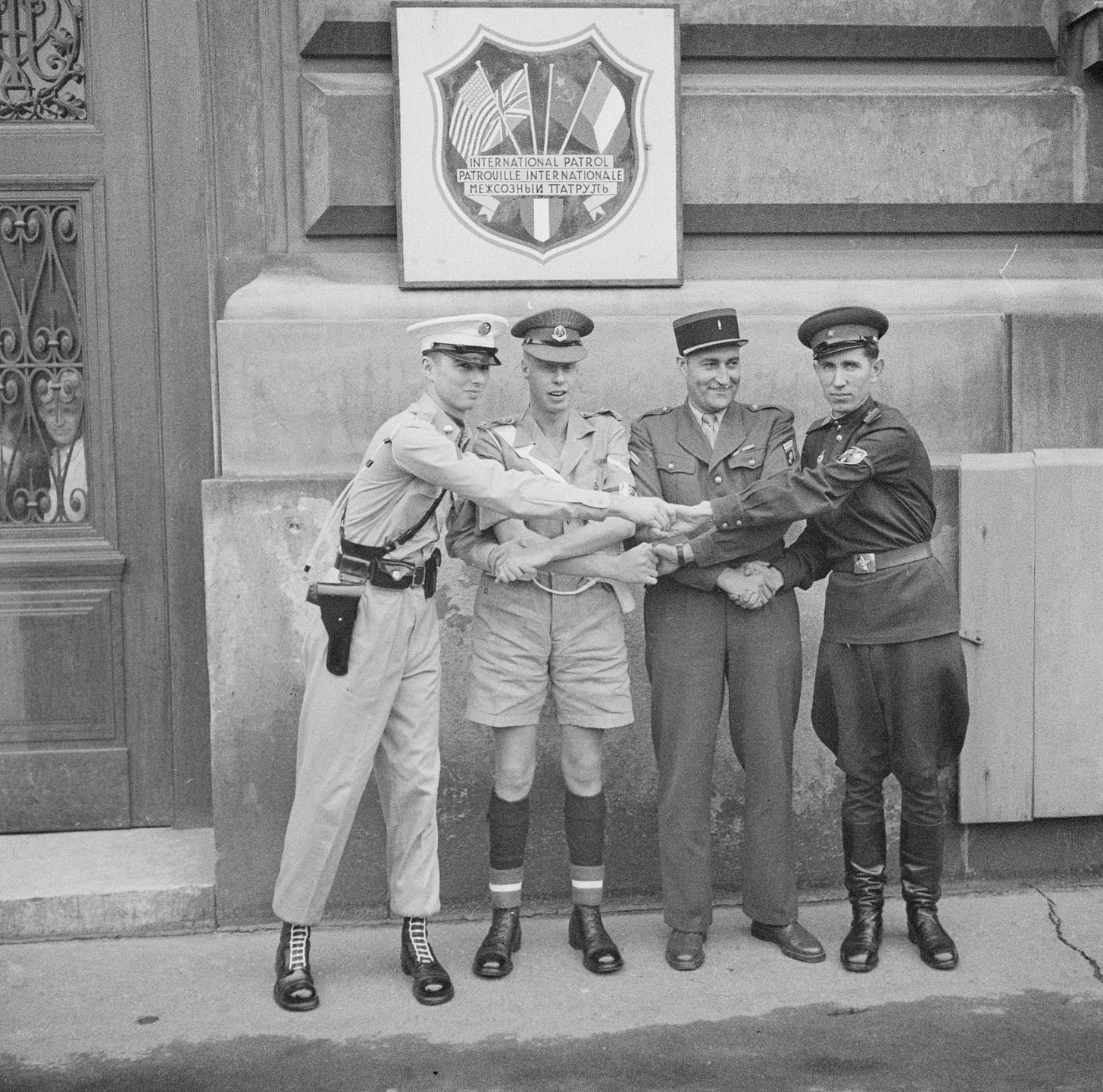Controlled Freedom: Allied Forces in Vienna
A new exhibition at the Wien Museum examines the Allies' postwar occupation of Vienna and its impact on the cultural realm in the context of the Cold War

Servus!
The Nazi regime’s unconditional surrender on May 8, 1945 marked the end of the Second World War in Europe. Fighting in Vienna had in fact concluded a few weeks prior. Following the failure of Operation Spring Awakening, the Nazis’ final large-scale offensive, Soviet forces—principally Marshal Fyodor Tolbukhin and the 3rd Ukrainian Front—drove towards Vienna, capturing the Austrian capital by April 15. The social democrat Theodor Körner—who had been imprisoned by the Nazis during the War—was appointed mayor of Vienna two days later.
The Allied Powers had predetermined with the signing of the Moscow Declaration in October 1943 that postwar Austria was to be an independent state, rendering the Anschluss or annexation of Austria by Nazi Germany in March 1938 to be null and void. The declaration also decreed Austria to be “the first free country to fall a victim to Hitlerite aggression,” a myth that would form part of the bedrock of postwar Austrian national identity, one it would only begin to shed itself of in the 1990s.
Thus, following Vienna and Austria’s “liberat[ion] from German domination” (as the Moscow Declaration would have it), Austria was established an independent republic under Allied four-party occupation. To the French: Vorarlberg and Tyrol in western Austria. The British took East Tyrol, Carinthia, and Styria in the south. The Americans: Salzburg and most of Upper Austria. Lower Austria and Burgenland went to the Soviets. As for Vienna: It was carved up between the Allied powers on a district-by-district basis, with the very center, the first district, turned into an international zone presided over by representatives of the four victorious powers.

The common sight of “four in a jeep”—one British, French, American, and Soviet officer each patrolling the first district in a military vehicle—became one of the defining images of the postwar Allied occupation in the Viennese collective imagination, argues a well-conceived and persuasive new exhibition at the Wien Museum, “Controlled Freedom: The Allies Forces in Vienna.” Allied troops established their own rules of law in Vienna, while aid from Western and Soviet governments provided for the reconstruction of the devastated city, including its heavily damaged infrastructure, industrial sector, and housing stock.
Thank you for reading The Vienna Briefing. Nothing beats a personal recommendation; if you know someone who would be interested in reading this newsletter, consider sharing it with them today.
The Vienna Briefing is a reader-supported publication. Your one-time or monthly tips make my work on this newsletter possible and help keep The Vienna Briefing free for everyone.
Allied soldiers were indeed a visible presence in Vienna—at least in the initial postwar years. “Controlled Freedom” contends, however, that contact between military and civilian populations was limited, for service personnel tended to live in parallel societies, frequenting leisure and entertainment venues like cinemas to swimming pools—and even bakeries—that were reserved exclusively of their use. Beyond the military and political, the real legacy of Allied occupation, “Controlled Freedom” argues, lies in the cultural realm, which Allied powers sought to shape, in particular as allies turned rivals in the context of the Cold War.
Part of Allied cultural policy in Vienna was directed towards establishing a post-Nazi and (in the case of the Western powers) democratic polity. The Allies sought to educate the public via exhibitions and screenings of documentary films about Nazi war crimes for which, again to quote from the Moscow Declaration, “Austria has a responsibility, which she cannot evade” due to its “participation in the war on the side of Hitlerite Germany.” The four powers also established their own newspapers like the Wiener Kurier, today’s Kurier, fostering a pluralistic media landscape.
Under Allied occupation, the Cold War played out in Austria’s cinemas, theatres, and art galleries. Viennese audiences could go see John Gielgud in King Lear at the Burgtheater, hear Leonard Bernstein lead the Vienna Philharmonic in his Jeremiah symphony, and visit ballets and art exhibitions funded by the French government. Austria’s Communist Party (KPÖ) operated a theater, the Neue Theater in der Scala, in the Soviet occupation zone; it was the only house in Vienna in which Bertolt Brecht’s work was performed. Across town at the Kosmos in the American zone, the sunnier aspects of American life were brought to a Viennese audience via its music and musical comedies.

West and East, capitalism and communism, also did battle in the picture house. Cinemas were reopened shortly after Vienna’s liberation, and at first, they mainly showed Soviet agitprop films like Battleship Potemkin or Sergei Eisenstein’s two-part dramatic epic Ivan the Terrible. In the end, however, neither Soviet film nor the opening salvos from domestic production were a match for Hollywood. Dumbo, Bambi, and Gone with the Wind were smash hits. These movies, as well as other signifiers of American culture like blue jeans and Coca-Cola, were not only a form of escapism from the harsh, drab realities of postwar Vienna. They were a type of positive association, a way for young Viennese to identify with something other than—and thus reject—Austria’s awful past.
“Controlled Freedom: The Allies Forces in Vienna” runs at the Wien Museum until September 7.
Bis bald!
The Vienna Briefing returns on May 21.




The exhibition is on my list of things to get to this summer.